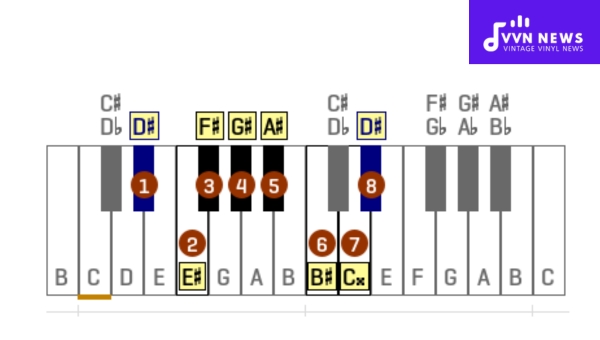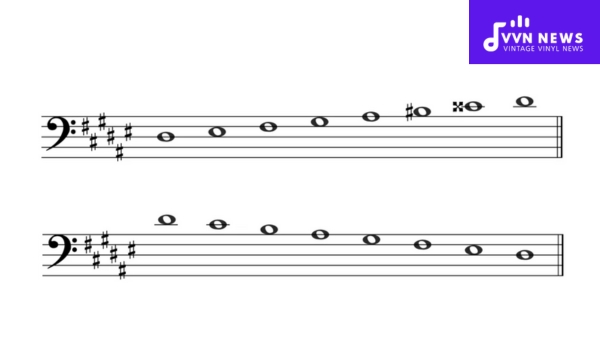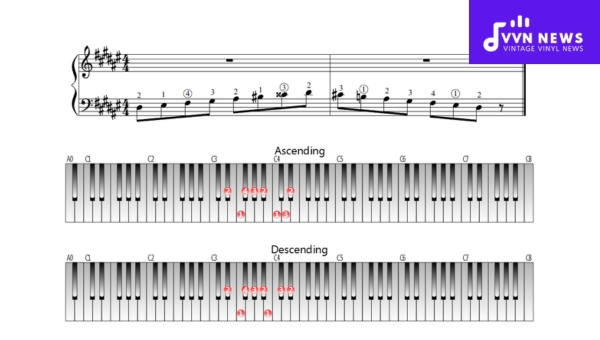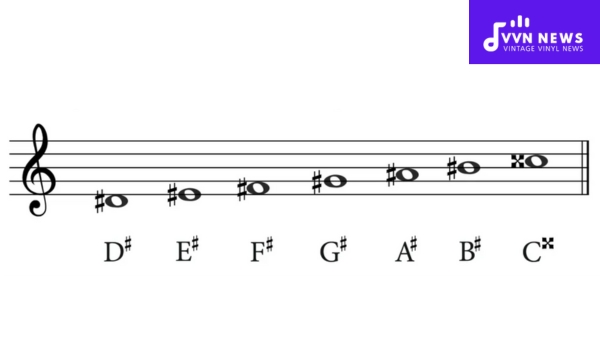As a musician, I’ve always been drawn to the nuanced sounds of various scales – the ways their notes can weave a story and evoke emotion. Among these, the D sharp melodic minor scale has emerged victoriously as one of my all-time favorites.
This may surprise some, especially considering the multitude of scales and tonal expressions available to musicians. Yet there’s something inimitably captivating about the D sharp melodic minor scale – an intriguing blend of melancholy and hope.
Many will agree that this scale offers a gateway to a unique musical landscape, rich in evocative tonalities and potential for expressive performance. It’s within this diverse sonic territory that we find ourselves whenever we journey through this lesser-known yet pivotal musical scale.
What intervals make up the D Sharp melodic minor scale?
To explore the intriguingly complex world of the D Sharp Melodic Minor scale, we must first understand its basic structure. The intervals that constitute this scale are the key to its unique sound.

Intervals Sequence:
- Tonic – D#
- Major second – E#
- Minor third – F#
- Perfect fourth – G#
- Perfect fifth – A#
- Major sixth – B#
- Major seventh – Cx
- Octave (Tonic, one octave higher) – D#
Each interval carries its own tonal weight, working coherently to shape the signature character of the D Sharp Melodic Minor scale.
Pay special attention to these intervals while practicing or composing with this exceptional scale; they truly encapsulate its essence.
Music is all about juxtaposition and contrast, and it’s precisely due to these varied intervals in the melodic minor that provide musicians with diverse possibilities for creating music full of expressiveness and rhythmic drive.
What is the formula for the melodic minor scale?
The melodic minor scale formula is uniquely expressive, with an interesting dichotomy of moods. Ascending, the scale buffers a minor third with major sixth and seventh degrees, while descending it mirrors a natural minor scale.
The ascending formula is: Whole, Half, Whole, Whole, Whole, Whole, Half (notated as W-H-W-W-W-W-H), and when descending, the formula follows a natural minor scale sequence: Whole, Whole, Half, Whole, Whole, Half, Whole (notated as W-W-H-W-W-H-W).
Its duality offers unlimited creative potential while ensuring ample room for an imaginative interpretation of melodies.
Whether you’re delving into complex jazz improvisations or creating haunting classical pieces.
Also Read: E Major: Scale And Chords [Exciting Sounds For Your Compositions]
What are the scale degrees in the ascending D Sharp melodic minor?
The melodic minor scale, as the name suggests, is defined by its melodious nature.

When it comes to the D sharp melodic minor scale, it has a unique arrangement of notes that makes it particularly captivating. Let’s elucidate this below:
- 1st degree – root/tonic – D#
- 2nd degree – supertonic – E#
- 3rd degree – mediant – F#
- 4th degree – subdominant – G#
- 5th degree – dominant – A#
- 6th degree – submediant – B#
- 7th degree – leading note – Cx
Each of these degrees carries an essential role in crafting a compelling melody within your composition. They’re not just identifiers but active contributors to your song’s overall feel and mood.
From start to finish – ‘D# to Cx’, every note in this scale is poised to bring a distinguishing effect on your music piece, making the journey from one degree to another fascinating.
These degrees determine how much tension or release a listener will experience during a tune.
Therefore these shouldn’t be looked upon merely as notes but treated as individual strokes on a painter’s canvas that together create a melodic masterpiece when played with knowledge and precision!
What degrees are used in the descending D Sharp melodic minor?
When it comes to melodic minor scales, one fascinating aspect is that these scales follow different sequences of notes when ascending and descending.
In terms of D Sharp melodic minor (also known as D#mM), the sequence shifts when we transition from ascending to descending.
D#mM in descent opens up a unique auditory experience. The pattern flows as follows:
- D# – The tonic, setting the baseline for this particular scale;
- C# – Transcends down a whole step;
- B – Again descends a whole step;
- A# – Drops half a step;
- G# – Then, another whole step down;
- F# – Followed by yet another full step down; and,
- E# – Lastly, takes one final half-step downwards to complete the sequence.
This cascade from top to bottom moves fluidly through each interval like a serene waterfall resting into its serene pond below —a harmonious and natural transition that creates beautiful soundscapes for both situated listeners and performers alike.
Playing the D Sharp Melodic Minor on Various Instruments
When it comes to playing the D sharp melodic minor scale, each instrument boasts its idiosyncrasies.
Below, I will walk you through the steps needed to successfully perform this unique scale on different musical instruments.
Piano
Think of the piano keys as a road map guiding you on your musical journey.
For many, visualizing a keyboard is often one of the most effective ways to comprehend and remember scales.
- As we start with D-sharp, press down on the black key immediately after D.
- Next comes E-sharp, which may connote a black key just like D-sharp due to its sharpness. In piano notation, E-sharp is simply the white key identified as F.
- The third step brings us to F-sharp, another black key that follows after F.
- The fourth note in our melodic sequence is G-sharp, which is positioned after G.
- Press your fingers down on the A-sharp, following the G-sharp.
- Lastly, B and then C-sharp bring us to the end of our octave.
Guitar
Playing the D Sharp Melodic Minor Scale on a guitar requires you to decode string numbers and fret positions.
Beginning on your sixth string (usually tuned to E), follow these steps:
- Start with finger position at the 11th fret
- Progress down to 13th fret
- Shift swiftly onto the 14th fret
- On the fifth string start at the 11th fret
- Move onto the 13th fret again
- Transition into the fourth string at the 11th fret
- Then hit the 12th fret
- Followed by finger position at the 14th fret and finally
- Shift to the third string at the 11th fret
Learning how this sequence feels beneath your fingers will build your muscle memory and aid in achieving fluid play over time.
Violin
On a violin, since it is fretless, it requires careful attention to detail. Start on the open E string (E0) and proceed:
- Play F sharp using the second finger in a low position on the E string.
- Press down the third finger on the G sharp note, still within your reach on the E string.
- Cross over to A string for both B (first finger) and C sharp (second finger).
By practicing these scales regularly you can master them, fostering growth in both your technical prowess and musical Knowledge.
Also Read: Phrygian Mode [Adding Exotic Flair To Your Musical Compositions]
Key Signature of D Sharp’s Melodic Minor Scale
The world of D sharp melodic minor scale can be exciting to navigate. With its unique turns and twists, each note explores a space that is unique to it.
Specifically, the key signature of this particular scale consists of nine sharps – F#, C#, G#, D#, A# / Bb, E# / F natural, B# / C natural in the ascending form, and F#, C#, G#, D#, A#, E#, B# in the descending form.
This balance between natural and sharpened notes contributes to that distinct melodic minor sound, with all playing crucial parts in the overall sonic tapestry.
The scale’s emotional lifeblood breathes through these nine sharps.
Experiencing these shifts in tonality can truly enrich your musical journey, whether as a listener or performer.
It’s this exploration that makes music such an enriching art form, forever pushing at boundaries and lending voices of radical expression to all who dare to venture into the exciting terrain of scales such as the D sharp melodic minor.
How is D Sharp’s melodic minor represented in different clefs?
The representation of the D Sharp melodic minor scale varies depending upon the clef it’s scribed in.

Let’s delve into this fascinating subject by examining how the scale is expressed in four primary musical clefs: Tenor, Alto, Bass, and Treble.
1. Tenor Clef
First, let’s move through the fascinating realm of the tenor clef. In the D sharp melodic minor scale, on a tenor clef, you’ll start from the line next to middle C (notated as a small “c” on the third line), and glide upwards to D#, E#, F#, G#, A#, B, Cx (double sharp), and finally to D#. This visually demonstrates where notes are placed rather elegantly.
2. Alto Clef
Next, let’s chart a course through the alto clef – where middle C sits smack dab in the center of it.
Here, your journey will start from D# above that central location and proceed similarly to the tenor clef representation, except for one key difference: instead of ascending all the way up to another D#, you’ll stop at an octave note lower.
3. Bass Clef
The bass clef awaits your exploration. The D sharp melodic minor scale starts two spaces above middle C and sequentially progresses through E#, F#, G#, A#, B, Cx before culminating in D# that sits just above the stave—providing a visual aid for those striking bass notes that vibrate lowly but resonate profoundly.
4. Treble Clef
Lastly, we can’t forget about treble clef! In this final representation, our scale’s initial point commences on a note that is located three lines above middle C – confidently launching itself into consecutive notes until it victoriously reaches its goal: another D#.
This allows musicians dealing in higher pitch ranges an excellent overview of their expected melody. To master these images within various clefs is akin to creating fluid musical conversations all over the stave.
It truly unlocks an additional level of freedom to compose, improvise, and enjoy the D sharp melodic minor scale’s charming beauty no matter what instrument you wield or what clef greets you on the page.
Also Read: How To Transpose Into The Tenor Clef? [Mastering In Notation]
What Chords are Found in the D Sharp Melodic Minor Scale?
Within the sonorous confines of the D sharp melodic minor scale, we find seven primary chords emerging from this delightful tonal landscape.
The main chords in the D# melodic minor scale, in respective order, are as follows: D#min/maj7, E#m7b5, F##maj7(#5), G##7, A##7, B#m7b5, and C#m6.
These chords each have a distinct quality closely tied to choppy rhythms and delicate balance that characterizes this fascinating melodic minor scale.
Should you explore further, you’ll discover that each chord provides a unique lens to experience and celebrate the rich sound world inherent within this exquisite scale.
D Sharp Melodic Minor Scale in Jazz
The D sharp melodic minor scale adopts a pivotal role in jazz music. Thanks to its dissonant, ambiguous sound, it adds much-needed tension and complexity to the pieces.
Often, jazz musicians employ the melodic minor mode interchangeably with other modes to imbue their compositions with a distinctive color and character.
Notably, they frequently use it over dominant 7th chords to achieve an altered dominant sound.
The D sharp melodic minor scale is also known to add richer textures to solos and improvisations in jazz. This characteristic sets it apart from other scales, making this scale more than just a basic building block of jazz.
Also Read: D Minor Triad [A Crucial Element In Music Composition]
FAQs
What does the D Sharp Melodic Minor Scale sound like?
The D Sharp Melodic Minor Scale is notable for its rich character, exuding a tonality filled with nuance – a blend of melancholy and hope.
Is the D Sharp Melodic Minor Scale frequently used in compositions?
While not as commonly deployed as major scales, the D Sharp Melodic Minor Scale features prominently in jazz, classical music, and several other musical genres owing to its expressive potential.
I am a beginner in music theory. Can I learn the D Sharp Melodic Minor scale easily?
Absolutely! Though it might seem intimidating at first, with consistent practice of its key components, you can master the D Sharp Melodic Minor scale.
How is this scale different from other melodic minor scales?
The distinct character of this scale lies in its specific intervals and position on the fretboard or keys which gives it a unique tonal aura.
What instruments can play the D Sharp Melotic Minor Scale?
Be it strings or keys- this versatile scale can be played on any instrument capable of changing pitches such as piano and guitar.
Also Read: How To Transpose Bass Clef To Treble Clef [A How-To Guide]
Conclusion
The journey through the D sharp melodic minor scale is a harmonizing adventure that captures the imagination in unique ways.
It’s an essential component in a musician’s repertoire. Whether you are an eagerly striving enthusiast or a seasoned performer, its complex structure and emotive potency can greatly enhance your musical skills and expression.
Now that we’ve uncovered its depths, we hope refinement of this distinct scale augments your musical narrative, further enmeshing your artistic footprint in listeners’ hearts. With time and patience, mastery of the D sharp melodic minor scale can be yours italic.








